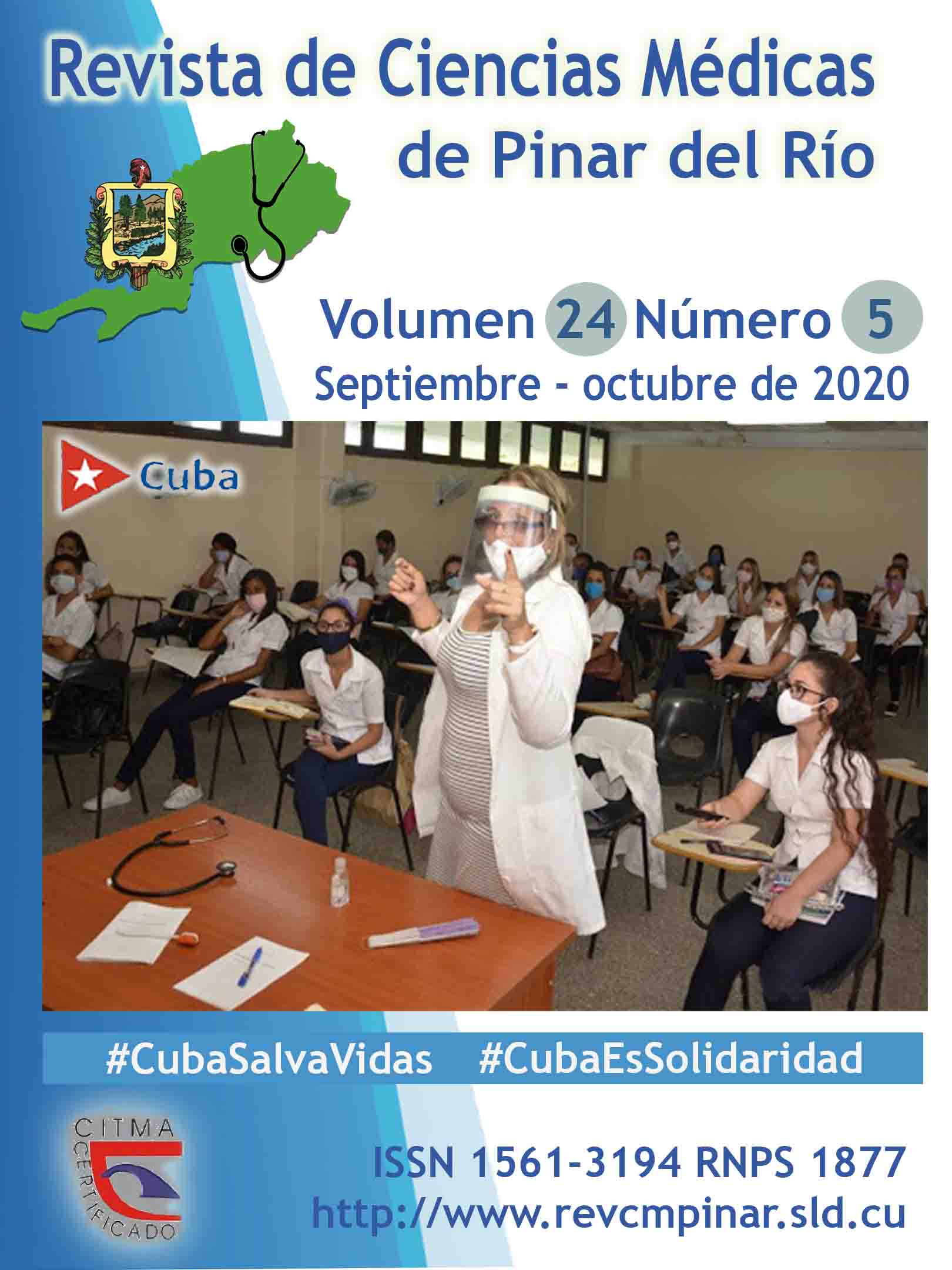Pemphigoid gestationis in the third trimester
Keywords:
PEMPHIGOID GESTATIONIS/diagnosis, PEMPHIGOID, BULLOUS, PREGNANT WOMEN.Abstract
Introduction: pemphigoid gestationis is a rare blistering disease characterized by an intensely itchy urticarial rash on the trunk and extremities that appears at the end of pregnancy and after delivery. It rapidly evolves into vesiculo ampullary dermatosis of the pemphigoid blistering type, since they have many clinical, histological and immune-pathological similarities.
Objectives: to present the clinical characteristics of a pregnant patient with pemphigoid gestationis.
Case Report: a pregnant woman with a prenatal history of a normal previous pregnancy; without skin lesions and a current 32-week pregnancy is presented. She was attended in the Dermatology Clinic at Raul Sanchez University Polyclinic where a polymorphic skin condition was evidenced by skin lesions in the form of small multiple, rounded plates of urticarial aspect and erythematous-papular filtered lesions, which were located in the abdomen, lower limbs and very pruritic rash. Clinical elements and histopathological study confirmed the diagnosis of pemphigoid gestationis. She received medical treatment achieving evident clinical progress.
Conclusions: a known clinical case was presented but of scarce incidence, therefore there are problems for its diagnosis and it must be taken into account due to the similarity with other skin dermatoses in pregnant women. It presents a morbidity risk for the newborn, maternal health is preserved in spite of its autoimmune etiology. The adequate diagnosis of this entity will allow a follow up along with an adequate medical treatment by a responsible multidisciplinary team, achieving an adequate quality of life and a better maternal-infant indicator.
Downloads
References
1. Kroumpouzos G, Cohen LM. Dermatosis of Pregnancy. J Am Acad Dermatol [Internet]. 2001 [Citado 26/01/2020]; 45(1): 1-19. Disponible en: https://www.sciencedirect.com/science/article/abs/pii/S0190962201496034?via%3Dihub
2. Tani N, Kimura Y, Koga H, Kawakami T, Ohata C, Ishii N, Hashimoto. Clinical and immunological profiles of 25 patients with pemphigoid gestationis. Br J Dermatol [Internet]. 2015 [Citado 26/01/2020]; 172(1):120-129. Disponible en: https://doi.org/10.1111/bjd.13374
3. Huilaja L, Makikallio K, Hannula-Jouppi K, Vakeva L, Hook Nikanne T. Cyclosporine Treatment in severe gestational pemphigoid. Acta dermato-venereologica [Internet]. 2015 [Citado 12/01/2020]; 95(5): 593-595. Disponible en: https://doi.org/10.2340/00015555-2032
4. Nguen T, Alragum A, Razzaque A. Positive clinical outcome with IVIg as monotherapy in recurrent pemphgoid gestatonis. Int Immunopharmacol [Internet]. 2015 [Citado 15/12/2019]; 26(1): 1-3. Disponible en:
http://dx.doi.org/10.1016/j.intimp.2015.02.038
5. Boudaya S, Turki H, Meziou TJ, Marrekchi S, BouassidaS, Zahal A. Pemphigoïde gestationis: une étude de 15 cas. J Gynecol Obstet Biol Reprod [Internet]. 2003 [Citado 15/12/2019]; 32(1): 30-4. Disponible en:
https://www.em-consulte.com/article/114630/pemphigoide-gestationis-une-etude-de-15-cas
6. García Pérez A. Pénfigo. Penfigoide. Otras dermatosis ampollosas esenciales. En: García Pérez A, editor. Dermatología Clínica. 5.ª ed. Salamanca: Cervantes, 1996; p. 305-21.
7. Al-Saif F, Elisa A, Al-Homidy A, Al-Ageel A, Al-Mubarak M. Retrospective analysis of pemphigoid gestationis in 32 Saudi patients – clinicopathological features and a literature review. J Reprod Immunol [Internet]. 2016 [Citado 20/12/2019]; 116: 42-45. Disponible en: https://doi.org/10.1016/j.jri.2016.04.286
8. Acosta Álvarez I, Valdés Suárez O, Valdés Cárdenas O, Coto Fernández A. Penfigoide gestacional una dermatosis específica del embarazo. Rev Cub de Medicina Intensiva y Emergencias [Internet]. 2016 [Citado 20/01/2020]; 15(3). Disponible en:
http://www.revmie.sld.cu/index.php/mie/article/view/164/html_61.
9. Savervall C, Sand Laerke F, Thomsen Francis S. Pemphigoid gestationis: current perspectives. Clinical, Cosmetic and Investigational Dermatology [Internet]. 2017 [Citado 29/11/2019]; 10: 441-449. Disponible en: https://www.dovepress.com/pemphigoid-gestationis-current-perspectives-peer-reviewed-article-CCID
10. García G, Ciganda Biain A, Bustinza Beaskoetxea Z, Martin Saez E, Obregón Martínez E, Martínez Guisasola J. Penfigoide gestacional. Clínica e Investigación en Ginecología y Obstetricia España [Internet]. 2017 [Citado 12/02/2020]; 44(1): 31-34. Disponible en: https://www.elsevier.es/es-revista-clinica-e-investigacion-ginecologia-obstetricia-7-articulo-penfigoide-gestacional-S0210573X15000726
11. De la Cruz C, Navarrete C, Majerson D, Romero W, Vergara A, González S. Penfigoide gestacional "Herpes gestationis". Revisión a partir de un caso clínico. Rev Chil Obstet Ginecol [Internet]. 2012 [Citado 12/12/2019]; 77(1): 64 – 71. Disponible en:
https://scielo.conicyt.cl/scielo.php?script=sci_arttext&pid=S0717-75262012000100013
12. Radia C, Salim G, Kawtar I, Fatima Zahra M, Taoufiq H. Pemphigoid gestationis: a Moroccan study. Our Dermatol Online. [Internet]. 2017 [Citado 12/12/2019]; 8(2): 128–132. Disponible en:
http://www.odermatol.com/odermatology/20172/1.Pemphigoid-RadiaC.pdf
13. Tourte M, Brunet-Possenti F, Mignot S, Gavard L. Descamp V. Pemphigoid gestationis: a successful preventive treatment by rituximab. J Eur Acad Dermatol Venereol [Internet]. 2017 [Citado 20/12/2019]; 31(4): e206-e207. Disponible en: https://pubmed.ncbi.nlm.nih.gov/27606493/
Downloads
Published
How to Cite
Issue
Section
License
Authors who have publications with this journal agree to the following terms: Authors will retain their copyrights and grant the journal the right of first publication of their work, which will be publication of their work, which will be simultaneously subject to the Creative Commons Attribution License (CC-BY-NC 4.0) that allows third parties to share the work as long as its author and first publication in this journal are indicated.
Authors may adopt other non-exclusive license agreements for distribution of the published version of the work (e.g.: deposit it in an institutional telematic archive or publish it in a volume). Likewise, and according to the recommendations of the Medical Sciences Editorial (ECIMED), authors must declare in each article their contribution according to the CRediT taxonomy (contributor roles). This taxonomy includes 14 roles, which can be used to represent the tasks typically performed by contributors in scientific academic production. It should be consulted in monograph) whenever initial publication in this journal is indicated. Authors are allowed and encouraged to disseminate their work through the Internet (e.g., in institutional telematic archives or on their web page) before and during the submission process, which may produce interesting exchanges and increase citations of the published work. (See The effect of open access). https://casrai.org/credit/



